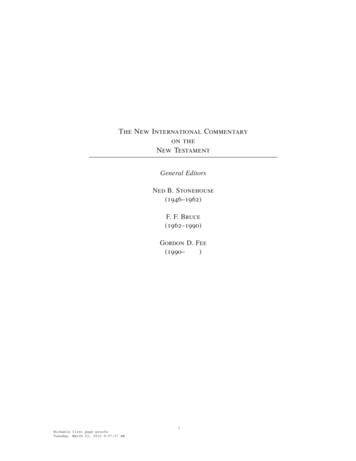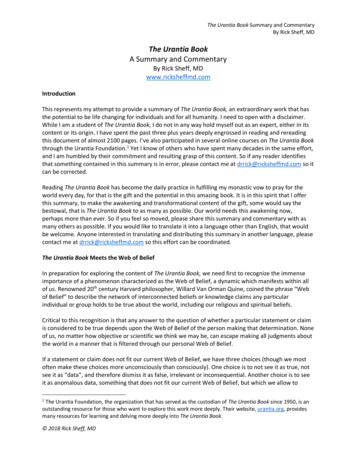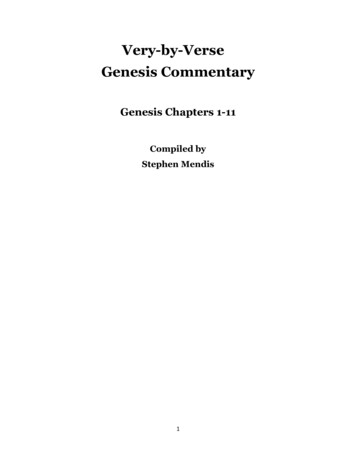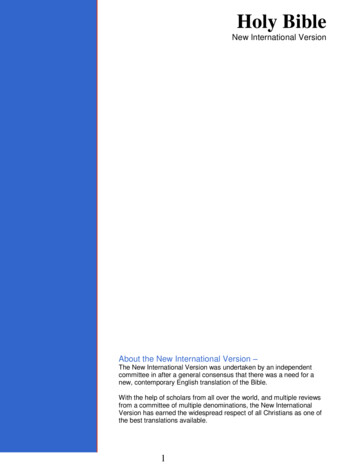
Transcription
Color profile: DisabledComposite Default screenThe New International Commentaryon theNew TestamentGeneral EditorsNed B. Stonehouse(1946–1962)F. F. Bruce(1962–1990)Gordon D. Fee(1990–)1Michaels first page proofsTuesday, March 23, 2010 9:57:37 AM
Color profile: DisabledComposite Default screen2Michaels first page proofsTuesday, March 23, 2010 9:57:37 AM
Color profile: DisabledComposite Default screenThe Gospel ofJOHNJ. RAMSEY MICHAELSWilliam B. Eerdmans Publishing CompanyGrand Rapids, Michigan / Cambridge, U.K.3Michaels first page proofsTuesday, March 23, 2010 9:57:37 AM
Color profile: DisabledComposite Default screen 2010 J. Ramsey MichaelsAll rights reservedPublished 2010 byWm. B. Eerdmans Publishing Co.2140 Oak Industrial Drive N.E., Grand Rapids, Michigan 49505 /P.O. Box 163, Cambridge CB3 9PU U.K.Printed in the United States of America15 14 13 12 11 107 6 5 4 3 2 1Library of Congress Cataloging-in-Publication DataISBN 978-0-8028-2302-1www.eerdmans.com4Michaels first page proofsTuesday, March 23, 2010 9:57:37 AM
Color profile: DisabledComposite Default screenCONTENTSEditor’s PrefaceviiiAuthor’s N1I. THE NATURE OF JOHN’S GOSPEL1II. THE AUTHORSHIP OF THE GOSPEL5A. “John” in Ancient TraditionsB. The Tradition Pro and ConC. That Disciple61217III. TRUTH CLAIMS24IV. JOHN AND THE OTHER GOSPELS27V. THE STRUCTURE OF JOHN’S GOSPELVI. LOCATION AND DATE3037VII. THEOLOGICAL CONTRIBUTIONS39TEXT, EXPOSITION, AND NOTES45I. PREAMBLE: THE LIGHT (1:1-5)II. THE TESTIMONY OF JOHN (1:6–3:36)A. John and the Coming of the Light (1:6-13)v5Michaels first page proofsTuesday, March 23, 2010 9:57:37 AM475758
Color profile: DisabledComposite Default screenContentsB.C.D.E.F.G.H.Our Testimony and John’s (1:14-18)John and Jesus (1:19-34)Jesus and John’s Disciples (1:35-51)Jesus at Cana and Capernaum (2:1-12)Jesus in the Temple at Passover (2:13-22)Jesus and Nicodemus at Passover (2:23–3:21)John’s Farewell (3:22-36)7493117139156171211III. JESUS’ SELF-REVELATION TO THE WORLD (4:1–12:50)228A.B.C.D.E.F.G.H.I.J.K.Jesus and the Samaritans (4:1-42)Jesus in Galilee Again (4:43-54)Jesus and the Sick Man in Jerusalem (5:1-18)Jesus’ Answer to the Jews in Jerusalem (5:19-47)Across the Lake and Back (6:1-21)Jesus and the Crowd at Capernaum (6:22-40)Jesus and the Jews at Capernaum (6:41-59)Jesus and His Disciples at Capernaum (6:60-71)To Jerusalem, or Not? (7:1-13)Jesus in the Temple (7:14-36)The Last Day of the Festival: Jesus and thePharisees (7:37–8:29)L. The Last Day of the Festival: Jesus and theJews Who Believed (8:30-59)M. Jesus and the Man Born Blind (9:1-38)N. Blind Guides and the Good Shepherd(9:39–10:21)O. Titles and Works (10:22-42)P. Going to Bethany (11:1-16)Q. The Raising of Lazarus, and Its Consequences(11:17-54)R. To Jerusalem Again (11:55–12:19)S. The Hour of Glorification (12:20-36)T. The Verdict on the World (12:37-50)IV. JESUS’ SELF-REVELATION TO THE DISCIPLES(13:1–17:26)vi6Michaels first page proofsTuesday, March 23, 2010 9:57:37 625659683706719
Color profile: DisabledComposite Default screenContentsA.B.C.D.E.F.G.Jesus at Supper (13:1-20)The Departure of Judas (13:21-35)Four Questions (13:36–14:31)Indwelling and the Love Command (15:1-17)The World and the Advocate (15:18–16:16)The Disciples’ Response (16:17-33)The Prayer for the Disciples (17:1-26)V. VERIFICATION OF JESUS’ SELF-REVELATION INHIS PASSION AND RESURRECTION (18:1–21:25)A.B.C.D.The Arrest and Hearing (18:1-27)Jesus, Pilate, and the Jews (18:28–19:15)The Crucifixion and Burial (19:16-42)The Empty Tomb and the First Appearance:Jesus and Mary (20:1-18)E. The Second Appearance: The Disciples andThomas (20:19-31)F. The Third Appearance and Simon Peter’sCommission 025INDEXESSubjectsAuthorsScripture ReferencesEarly Extrabiblical Literaturevii7Michaels first page proofsWednesday, May 19, 2010 9:49:03 AM1059106510691089
Color profile: DisabledComposite Default screenEDITOR’S PREFACEI take great pleasure in introducing this commentary on John’s Gospel to thelarger Christian community of scholars and students. In one of my earliestyears in the role of editor of this series, I had opportunity to visit ProfessorLeon Morris at his home in Melbourne, New South Wales, who was at thattime in his ninetieth year. He agreed to work on a revision of his commentarythat had first appeared in 1971. The revised edition appeared in 1995. But fora number of reasons the “revision” turned out to be much more cosmetic thansubstantial. So after his passing, I approached my former colleague and longtime friend, J. Ramsey Michaels, as to whether, in keeping with what washappening elsewhere in the series, he would like to offer a replacement volume. The present superb exposition of the Gospel of John is the end productof his agreeing to do so.It is a special personal pleasure to welcome Ramsey’s contribution tothis series, since our own relationship dates to 1974 when Andrew Lincolnand I joined him and David Scholer on the New Testament faculty at GordonConwell Seminary in Massachusetts, where the four of us (and our spouses)spent five wonderful years together. I had taught the Gospel of John atWheaton College before moving to Gordon-Conwell, and it was this movethat also shifted my primary New Testament focus from John to Paul, sincethe Johannine material was in Ramsey’s very good hands. So I owe Ramsey apersonal debt of gratitude for this move, which turned out to mark most ofthe rest of my New Testament career (apart from a commentary on the Revelation due out in 2010).Whereas one might well question whether the scholarly/pastoralworld needs yet another commentary on this Gospel, anyone who takes thetime to read or use this work will easily recognize that the answer is “yes.”Here is a substantial, truly original, work of extraordinary insight and helpfulness to pastor and scholar alike, which should have a considerable lifespan well after both author and editor have gone to their eternal reward. Whatviii8Michaels first page proofsTuesday, March 23, 2010 9:57:37 AM
Color profile: DisabledComposite Default screenEditor’s Prefacethe careful reader and user of this commentary will recognize is the largenumber of insights into this Gospel, which, for want of a better term, must bejudged as “new.” But that does not mean “eccentric”; rather they are the result of many years of focused labor — and love — for John’s Gospel. I amtherefore pleased to commend it to one and all.Gordon D. Feeix9Michaels first page proofsTuesday, March 23, 2010 9:57:37 AM
Color profile: DisabledComposite Default screenAUTHOR’S PREFACEThis commentary represents a second effort, building to some extent on thefirst (1984 and 1989),1 but attempting a far more detailed exposition of thetext. I used to tell my friends that I keep trying until I get it right. The charmof the enterprise, of course, is that one never quite “gets it right.” Moreover,as I get older I am increasingly conscious of the mortality rate among somewho have written on John’s Gospel. Edwyn Hoskyns’s commentary had to befinished and edited by F. N. Davey (1947), R. H. Lightfoot’s by C. F. Evans(1956), J. N. Sanders’ by B. A. Mastin (1968), and Ernst Haenchen’s by Robert W. Funk and Ulrich Busse (1980). Yet I am encouraged by the example ofC. H. Dodd, who completed his first great work on the Gospel of John, TheInterpretation of the Fourth Gospel, in 1953 at the age of 69, and his second,Historical Tradition in the Fourth Gospel, ten years later.It may help readers to know from the start what this commentary willprovide and what it will not. First, I have not begun to monitor all the publications on the Gospel in the seventeen years that have passed since I firstsigned the contract with Eerdmans (I may even have missed a few from before that!). Rather, I have tried to immerse myself in the text itelf, while interacting repeatedly with the major commentators, past and present, such asBultmann, Schnackenburg, Brown, and Barrett (the first tier, more or less),and a number of others from whom I have learned a great deal, includingLeon Morris, my predecessor in the NICNT series, Westcott, Hoskyns,Lindars, Lincoln, Carson, Beasley-Murray, Keener, Moloney, and my ownyounger self. The list could go on and on. To my surprise I found RudolfBultmann’s commentary the most useful of all, a work widely admired for allthe wrong reasons. Bultmann’s theories of source, redaction, and displace1. See my John: A Good News Commentary (San Francisco: Harper and Row,1984) and John, NIBC 4 (Peabody, MA: Hendrickson, 1989). The latter differs from theformer only in being based on the NIV rather than the TEV, or Good News Bible.x10Michaels first page proofsTuesday, March 23, 2010 9:57:37 AM
Color profile: DisabledComposite Default screenAuthor’s Prefacement have not survived and should not, yet his eye for detail is unsurpassed,and his close reading of the text as it stands — even when he discards it —perceptive and illuminating. It is only a slight oversimplification to say thatBultmann interprets the Gospel correctly (more or less), finds it unacceptable, and then rewrites it. His greatness lies in the first of those three things.To a degree, I have also dealt with the relevant periodical literature, but forsomething close to an exhaustive bibliography the student will have to lookelsewhere. Keener’s 167 pages (!) is a good, up-to-date place from which tostart.2Second, I have not spent a great deal of time on the “background” ofthe Gospel (whatever that might mean), whether in Judaism, Hellenism, Hellenistic Judaism, Qumran, Gnosticism, or whatever. It is customary to do thisin relation to the Gospel of John but not to any great extent in relation to theother three Gospels, because of the assumption that this Gospel somehow hasa unique “background” not shared by the others. I am not so sure that this istrue. I am more sure that its background, like that of all the Gospels, ismixed, that its main ingredients are the Jewish Bible, Second Temple Judaism (both Palestinian and Hellenistic), and primitive Christianity, and that theinterpreter should have an eye open for relevant parallels (be they background or foreground) in Gnosticism as well. “Background,” to my mind, isbetter assessed in relation to particular passages than in generalities.Third, and consequently, I have kept the Introduction relatively short,at least in relation to the size of the commentary as a whole. Not only theGospel’s historical and cultural background, but its use of sources, its relationship to other Gospels and other New Testament documents, its literarystyle, its christology and theology, all of those issues are as well, or better,addressed as they come up in connection with the relevant texts than at theoutset, before one has even started reading. Leon Morris’s introduction ran toalmost sixty pages, Raymond E. Brown’s to well over a hundred,3 C. K.Barrett’s to almost 150, Schnackenburg’s to just over two hundred — andCraig Keener’s to 330 pages! Yet, by contrast, Bultmann’s commentary inGerman had no introduction at all, and when Walter Schmithals added onefor English readers in 1971, it took up a modest twelve pages! So I will notapologize for a comparatively short introduction centered largely on thequestion of authorship. In any event, I have always suspected that the so2. See Craig S. Keener, The Gospel of John: A Commentary (Peabody, MA:Hendrickson, 2003), 2.1257-1409.3. This is not quite fair to Brown, inasmuch as his introduction was expanded after his death into a 356-page book (Raymond E. Brown, An Introduction to the Gospel ofJohn: Edited, Updated, Introduced, and Concluded by Francis J. Moloney, Anchor BibleReference Library; New York: Doubleday, 2003).xi11Michaels first page proofsTuesday, March 23, 2010 9:57:37 AM
Color profile: DisabledComposite Default screenAuthor’s Prefacecalled “Introduction” should come after the Commentary proper, not before.I wrote it last, and it would not be a bad idea to read it last.Finally, I have given the priority to understanding the text in its present form, just as it has come down to us, rather than tracing the history ofhow it came to be. The sources of John’s Gospel, whether one or more of theother Gospels, the oral traditions behind them, or a putative “Signs Source,”or “Revelation Discourse,” are of secondary interest, often consigned to footnotes. I do not assume that something in the Gospel which is there by default,as it were, having been taken over from an earlier source, is necessarily lessimportant to the writer than the editorial work the writer has brought to it. Inthe current jargon, the approach taken here is synchronic, not diachronic. Ihave assumed that the Gospel of John as we have it is a coherent literarycomposition, and I have attempted to read it as such — even while alertingthe reader to the supposed difficulty of doing so in certain places.4 Sometimes I am asked, “Does the Gospel of John put words in Jesus’ mouth?” Myanswer, which will become evident in the Commentary, is “Perhaps so,though not as often as some might think,” and when I conclude that it does,my job as a commentator is to leave them there.Given the choice of using the NIV (or TNIV) translation, or makingone of my own, I chose the latter course. I prefer not to use up space eitherdefending or quarreling with the peculiarities of a given English version. Myown translation is painfully literal, deliberately so, sometimes almost to thepoint of unintelligibility. Its sole value is to give the reader without knowledge of Greek some idea of the structure and syntax of the original. It is notintended to stand on its own, and it should never ever be made to do so! Asfor the text, I have generally followed the Nestle-Aland Greek New Testament (26th and 27th editions, depending on what I had available). When I departed from it (for example, at 1:15 and at 12:17), I have indicated why,sometimes at considerable length.This second effort of mine has been largely carried out during retirement years, yet it is the product of a half-century in the classroom, at GordonDivinity School, Gordon-Conwell Theological Seminary, Andover Newton,Missouri State University, and in retirement Fuller Seminary in Pasadena andSeattle, and Bangor Seminary in Portland, Maine. I am grateful to the students in all those places whom I taught and who taught me a thing or two.4. That is, certain so-called aporias, or awkward transitions, prompting theoriesof displacement (for example, the proposed reversal of chapters 5 and 6), theories of twofarewell discourses separated by “Rise, let’s get out of here!” (14:31), and attempts to separate certain passages from the Gospel proper, either as later additions by a different hand(for example, chapter 21, or 6:52-58), or as earlier and more primitive formulations (forexample, parts of 1:1-18 and the so-called “Signs Source”).xii12Michaels first page proofsTuesday, March 23, 2010 9:57:37 AM
Color profile: DisabledComposite Default screenAuthor’s PrefaceThree of them — Ben Witherington (1995), Rod Whitacre (1999), and CraigKeener (2003) — have written fine commentaries of their own on the Gospelof John. So has Homer A. Kent Jr., professor and later president of GraceTheological Seminary (Light in the Darkness: Studies in the Gospel of John,1974), who in the Spring of 1953, as I recall, introduced me to John’s Gospelin the classroom. To them I dedicate this volume. Homer’s lectures were verywell organized, but what I remember best were twenty-one assigned “problem texts” he gave us to deal with, one to a chapter. That, with the help ofWestcott’s commentary on the English text and Merrill Tenney’s John: TheGospel of Belief, was what got me started.In more recent years, I benefited from interaction with colleagues, including Gordon Fee at Gordon-Conwell (now my General Editor), CharlieHedrick at Missouri State, and the late David Scholer at Fuller. Still more recently — down the “home stretch,” as it were — I had a lot of encouragementfrom a clergy support group in New Hampshire consisting of six or sevenpastors of small American Baptist churches (my own pastor among them).We worked together mostly on case studies, giving me a sense of what the rural and small city pastor has to deal with, outside the orbit of the megachurch.I am grateful for their prayers, and I hope the commentary meets their expectations, for they are fairly typical of the audience for which I am writing.And of course there is my wife Betty, who has loved me and whom Ihave loved ever since that Spring of 1953 when I first got acquainted with theGospel of John.J. Ramsey Michaelsxiii13Michaels first page proofsTuesday, March 23, 2010 9:57:37 AM
Color profile: DisabledComposite Default GDouayERVESVFCGCSGNBHTRISBEJBAnte-Nicene Fathers. 10 vols. Grand Rapids: Eerdmans, n.d.Apocrypha and Pseudepigrapha of the Old Testament, editedby R. H. Charles. 2 vols. Oxford: Oxford University Press,1913American Standard Version (1901)Bauer, Walter. A Greek-English Lexicon of the NewTestament and Other Early Christian Literature. 3d ed.revised and edited by F. W. Danker. Chicago: The Universityof Chicago Press, 2000Blass, F. and Debrunner, A. A Greek Grammar of the NewTestament and Other Early Christian Literature, edited byR. W. Funk. Chicago: The University of Chicago Press, 1961Bibliotheca SacraCatholic Biblical QuarterlyContemporary English Version (1995)Dictionary of Jesus and the Gospels. Downers Grove, IL:InterVarsity Press, 1992Holy Bible: Douay Version (1956)English Revised Version (1881)English Standard Version (2001)Fathers of the Church: A New Translation. Washington, DC:Catholic University of America Press, 1947-63Die griechischen christlichen Schriftsteller der erstenJahrhunderteGood News Bible (1976)Harvard Theological ReviewInternational Standard Bible Encyclopedia. Grand Rapids:Eerdmans, 1979-88Jerusalem Bible (1966)xiv14Michaels first page proofsTuesday, March 23, 2010 9:57:37 AM
Color profile: DisabledComposite Default al of Biblical LiteratureJournal for the Study of the New TestamentSupplements to Journal for the Study of the New TestamentJournal of Theological StudiesKing James Version (1611)Loeb Classical Library. Harvard University Press.H. G. Liddell and R. Scott, A Greek-English Lexicon, revisedby H. S. Jones. Oxford: Oxford University Press, 1996LXXThe Septuagint, or Greek Version of the Old Testament.NA27Nestle-Aland. Novum Testamentum Graece. 27th ed.Stuttgart: Deutsche Bibelgesellschaft, 2001NABNew American Bible (1970)NASBNew American Standard Bible (1977)NEBNew English Bible (1961)NIBCNew International Biblical Commentary. Peabody, MA:Hendrickson, 1989NICNTNew International Commentary on the New TestamentNIVNew International Version (1978)NJBNew Jerusalem Bible (1999)NLTNew Living Translation (1996)NPNFNicene and Post-Nicene Fathers of the Christian Church.Grand Rapids: Eerdmans, n.d.NRSVNew Revised Standard Version (1989)NTSNew Testament StudiesOTPOld Testament Pseudepigrapha, edited by J. H.Charlesworth. Garden City, NY: Doubleday, 1983-85PLPatrologia LatinaRBRevue BibliqueREBRevised English Bible (1989)RHPRRevue d’Histoire et de Philosophie ReligieuseRSVRevised Standard Version (1952)SBLSociety of Biblical LiteratureSNTSStudiorum Novi Testamenti SocietasStrackStrack, H. L., and Billerbeck, P. Kommentar zum NeuenBillerbeck Testament aus Talmud und Midrasch. 6 vols. Munich: Beck,1922-61TDNTTheological Dictionary of the New Testament. 10 vols.Grand Rapids: Eerdmans, 1964-83TEVToday’s English VersionTNIVToday’s New International Version (2005)WUNTWissenschaftliche Untersuchungen zum Neuen TestamentZNWZeitschrift für die neutestamentliche Wissenschaftxv15Michaels first page proofsTuesday, March 23, 2010 9:57:37 AM
Color profile: DisabledComposite Default screenBIBLIOGRAPHYI. PRIMARY SOURCESThese include texts and translations of the Gospel of John and of ancient sources relevant to its interpretation, other than those listed under the the table of Abbreviations.This involves a judgment call, in that English (and other) translations are viewed as insome sense primary texts rather than as commentaries.Apocrypha, II: Evangelien (ed. E. Klostermann). 3d ed. Berlin: Walter de Gruyter,1929.Authorized Daily Prayer Book (rev. ed.). New York: Bloch, 1960.The Babylonian Talmud (ed. I. Epstein). 18 vols. London: Soncino, 1935-61.Bell, H. I., and Skeat, T. C. (eds.). Fragments of an Unknown Gospel and OtherEarly Christian Papyri. London: Published by the Trustees, 1935.The Catholic Study Bible. NAB. Oxford: Oxford University Press, 1990.Charles, R. H. The Book of Enoch. Oxford: Clarendon, 1912.Danby, Herbert. The Mishnah. Oxford: Oxford University Press, 1933.Fenton, Ferrar. The Holy Bible in Modern English. Merrimac, MA: Destiny,1966.García Martínez, F. The Dead Sea Scrolls Translated. Leiden: Brill, 1994.Ginzberg, Louis. Legends of the Jews. Philadelphia: Jewish Publication Society,1909ff.Grant, R. M. Second-Century Christianity. London: SPCK, 1957.¾¾¾. Gnosticism. New York: Harper & Brothers, 1961.Harvey, W. W. Sancti Irenaei Episcopi Lugdunensis: Libris quinque adversusHaereses. 2 vols. Cambridge: Typis Academicis, 1857.Hawthorne, Gerald F. “A New English Translation of Melito’s Paschal Homily,”in Current Issues in Biblical and Patristic Interpretation (ed. G. F. Hawthorne; Grand Rapids, Eerdmans, 1975), 147-75.xvi16Michaels first page proofsTuesday, March 23, 2010 9:57:37 AM
Color profile: DisabledComposite Default screenBibliographyHennecke, Edgar, and Schneemelcher, Wilhelm. New Testament Apocrypha. 2vols. Philadelphia: Westminster, 1964.James, M. R. The Apocryphal New Testament. Oxford: Clarendon, 1924.Joseph Smith’s “New Translation” of the Bible. Independence, MO: Herald,1970.Knox, Ronald. The New Testament of Our Lord and Saviour Jesus Christ: A NewTranslation. New York: Sheed & Ward, 1946.Lattimore, Richmond. The New Testament. New York: North Point, 1996.Layton, Bentley. The Gnostic Scriptures: A New Translation. New York: Doubleday Paperback, 1995.Lewis, Agnes Smith. A Translation of the Four Gospels from the Syriac of theSinaitic Palimpsest. London: Macmillan, 1894.Mekilta de-Rabbi Ishmael on Exodus (ed. J. Z. Lauterbach). Philadelphia: JewishPublication Society, 1976.Midrash Rabbah (ed. H. Freedman and M. Simon). 10 vols. London: Soncino,1961.Montgomery, Helen Barrett. The New Testament in Modern English. CentenaryTranslation. Philadelphia: Judson, 1924.The New Testament and Psalms: An Inclusive Version. New York: Oxford University Press, 1995.The New Testament in Basic English. New York: E. P. Dutton, 1941.The New World Translation. Brooklyn: Watchtower and Tract, 1961.Neusner, Jacob. Sifre to Deuteronomy: An Analytical Translation. Atlanta:Scholars Press, 1987.Nock, A. D., and Festugière, A.-J. Corpus Hermeticum, Tome I: Traités I-XII.Paris: Société d’Édition, 1960.The Odes of Solomon: The Syriac Texts (ed. James Charlesworth). Missoula,MT: Scholars Press, 1977.Palestine in the Fourth Century A.D.: The Onomasticon by Eusebius of Caesarea.Jerusalem: Carta, 2003.Pesikta de-Rab Kahana (ed. W. G. Braude and I. J. Kapstein). Philadelphia: Jewish Publication Society, 1975.Phillips, J. B. The New Testament in Modern English. London: Geoffrey Bles,1963.Roberts, C. H. (ed.). An Unpublished Fragment of the Fourth Gospel in the JohnRylands Library. Manchester: Manchester University Press, 1935.Robinson, James M. (ed.). The Nag Hammadi Library in English. 3rd ed. SanFrancisco: Harper & Row, 1988.Rotherham, J. B. Emphasized New Testament. Grand Rapids: Kregel, 1959.Stern, Menahem (ed.). Greek and Latin Authors on Judaism. 3 vols. Jerusalem:Israel Academy of Sciences and Humanities, 1976-84.Tertullian’s Homily on Baptism (ed. E. Evans). London: S.P.C.K., 1964.xvii17Michaels first page proofsTuesday, March 23, 2010 9:57:37 AM
Color profile: DisabledComposite Default screenBibliographyThe Twentieth-Century New Testament (rev. ed.). New York: Fleming H. Revell,1904.Vermes, Geza. The Complete Dead Sea Scrolls in English. New York: AllenLane: Penguin, 1997.Völker, W. (ed.). Quellen zur Geschichte der christlichen Gnosis. Tübingen:Mohr (Siebeck), 1932.Wade, G. W. Documents of the New Testament. London: Thomas Murby, 1934.Wakefield, Gilbert. A Translation of the New Testament. Cambridge, MA: Harvard University Press, 1820.Westcott, B. F., and Hort, F. J. A. The New Testament in the Original Greek. NewYork: Harper and Brothers, 1882.Wetstein, J. J. Novum Testamentum Graece. Amsterdam, 1751.Wilkinson, John. Egeria’s Travels to the Holy Land. Jerusalem: Ariel, 1981.Williams, Charles B. The New Testament: A Private Translation in the Languageof the People. Chicago: Moody, 1960.II. COMMENTARIES ON THE GOSPEL OF JOHNModern commentaries will normally be cited merely by the author’s last name andthe page number. If the author has written secondary commentaries, or other worksthat are in the Bibliography, these will be cited by a keyword from the title.Augustine. Homilies on the Gospel of John. NPNF. 1st ser., 7.7-452. GrandRapids: Eerdmans, 1978.Barrett, C. K. The Gospel According to John. 2d ed. Philadelphia: Westminster,1978.Beasley-Murray, G. R. John. Word Biblical Commentary 36. Waco, TX: Word,1987.Bengel, J. A. Gnomon of the New Testament. 5 vols. Edinburgh: T&T Clark, n.d.Bernard, J. H. A Critical and Exegetical Commentary on the Gospel Accordingto John. 2 vols. International Critical Commentary. Edinburgh: T&TClark, 1928.Brodie, Thomas L. The Gospel According to John: A Literary and TheologicalCommentary. New York: Oxford University Press, 1993.Brown, Raymond E. The Gospel According to John. 2 vols. Anchor Bible 29 and29A. Garden City, NY: Doubleday, 1966 and 1970.Bultmann, Rudolf. The Gospel of John: A Commentary. Philadelphia: Westminster, 1971.Calvin, John. Calvin’s Commentaries 7: The Gospels. Grand Rapids: AssociatedPublishers, n.d.xviii18Michaels first page proofsTuesday, March 23, 2010 9:57:38 AM
Color profile: DisabledComposite Default screenBibliographyCarson, Donald. The Gospel According to John. Grand Rapids: Eerdmans, 1991.Chrysostom. Homilies on the Gospel of St. John. NPNF. 1st ser., 14.1-334. GrandRapids: Eerdmans, 1978.Haenchen, Ernst. John 1: A Commentary on the Gospel of John, Chapters 1–6.Philadelphia: Fortress, 1984.¾¾¾. John 2: A Commentary on the Gospel of John, Chapters 7–21. Philadelphia: Fortress, 1984.Hoskyns, Edwyn C. The Fourth Gospel (ed. F. N. Davey). London: Faber andFaber, 1947.Keener, Craig S. The Gospel of John: A Commentary. 2 vols. Peabody, MA:Hendrickson, 2003.Kent, Homer A., Jr. Light in the Darkness: Studies in the Gospel of John. WinonaLake, IN: BMH, 1974.Lightfoot, R. H. St. John’s Gospel: A Commentary (ed. C. F. Evans). Oxford:Oxford Paperbacks, 1960.Lincoln, Andrew T. The Gospel According to Saint John. Black’s New TestamentCommentary 4. Peabody, MA: Hendrickson, 2005.Lindars, Barnabas. The Gospel of John. Greenwood, SC: Attic Press, n.d.Marsh, John. Saint John. Westminster Pelican Commentaries. Philadelphia:Westminster, 1968.Michaels, J. Ramsey. John. NIBC 4. Peabody, MA: Hendrickson, 1989.Moloney, F. J. The Gospel of John. Sacra Pagina 4. Collegeville, MN: LiturgicalPress, 1998.¾¾¾. Belief in the Word: Reading John 1–4. Minneapolis: Fortress, 1993.¾¾¾. Signs and Shadows: Reading John 5–12. Minneapolis: Fortress, 1996.¾¾¾. Glory, Not Dishonor: Reading John 13–21. Minneapolis: Fortress, 1998.Morris, Leon. The Gospel According to John: Revised Edition. NICNT. GrandRapids: Eerdmans, 1995.Origen. Commentary on the Gospel of John: Books 1-10 (trans. R. E. Heine). FC80. Washington, DC: Catholic University of America Press, 1989.¾¾¾. Commentary on the Gospel of John: Books 13-32 (trans. R. E. Heine).FC 89. Washington, DC: Catholic University of America Press, 1993.Sanders, J. N., and Mastin, J. A. A Commentary on the Gospel According to St.John. London: Adam & Charles Black, 1968.Schnackenburg, Rudolf. The Gospel According to St. John. 3 vols. New York:Crossroads, 1982.Wesley, John. Explanatory Notes upon the New Testament. London: WilliamBowyer, 1755.Westcott, B. F. The Gospel According to St. John: The Greek Text with Introduction and Notes. Grand Rapids: Eerdmans, 1954.Whitacre, Rodney A. John. IVP New Testament Commentary 4. Downers Grove,IL: InterVarsity Press, 1999.xix19Michaels first page proofsTuesday, March 23, 2010 9:57:38 AM
Color profile: DisabledComposite Default screenBibliographyWitherington, Ben III. John’s Wisdom: A Commentary on the Fourth Gospel.Louisville: Westminster John Knox, 1995.III. OTHER SECONDARY WORKS CITEDAbbot, Ezra. “The Distinction between aiteZ and erZtaZ,” in The Authority of theFourth Gospel (Boston: Ellis, 1888), 113-36.Abbott, Edwin A. Johannine Vocabulary. London: Adam and Charles Black,1905.¾¾¾. Johannine Grammar. London: Adam and Charles Black, 1906.Aland, K. “Eine Untersuchung zu Joh 1:3-4: Über die Bedeutung eines Punktes.”ZNW 59 (1968), 174-209.Alter, Robert. The Art of Biblical Narrative. New York: Basic Books, 1981.Anderson, Paul N. The Christology of the Fourth Gospel: Its Unity and Disunityin the Light of John 6. WUNT. Tübingen: Mohr, 1996.Anderson, Paul N., Just, Felix, S. J., and Thatcher, Tom (eds.). John, Jesus, andHistory, Volume 1: Critical Appraisals of Critical Views. Atlanta: Societyof Biblical Literature, 2007.Atwood, Craig D. Community of the Cross: Moravian Piety in Colonial Bethlehem. University Park, PA: Pennsylvania State University Press, 2004.Aune, David E. Prophecy in Early Christianity and the Ancient MediterraneanWorld. Grand Rapids: Eerdmans, 1983.Bammel, Ernst. “Philos tou Kaisaros.” Theologische Literaturzeitung 77 (1952),205-10.¾¾¾. “John Did No Miracles: John 10:41,” in Miracles (
The New International Commentary on the New Testament General Editors Ned B. Stonehouse (1946–1962) F. F. Bruce (1962–1990) Gordon D. Fee (1990– ) 1 Michaels first page proofs Tuesday, March 23, 2010 9:










